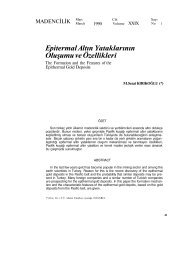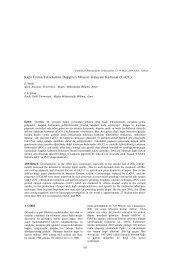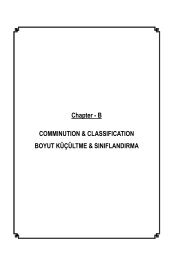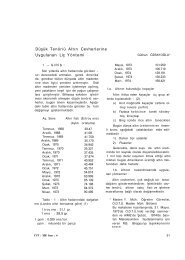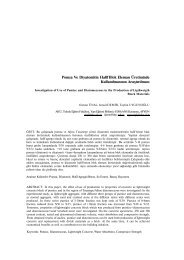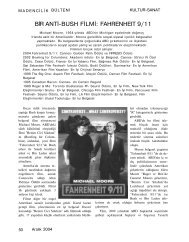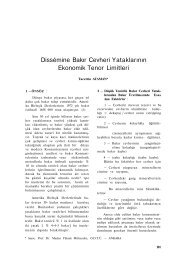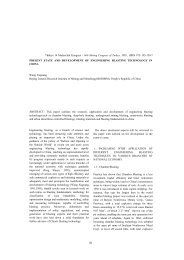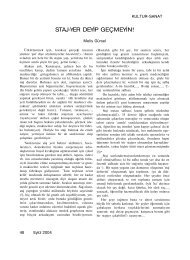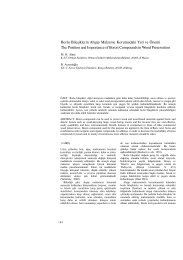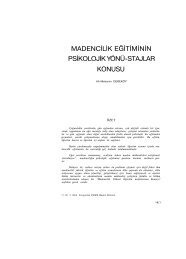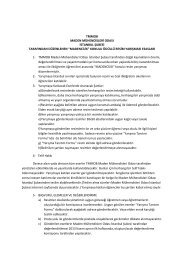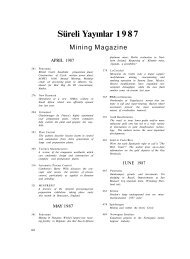A OPEN PIT MINING AÇIK OCAK MADENCİLİĞİ
A OPEN PIT MINING AÇIK OCAK MADENCİLİĞİ
A OPEN PIT MINING AÇIK OCAK MADENCİLİĞİ
Create successful ePaper yourself
Turn your PDF publications into a flip-book with our unique Google optimized e-Paper software.
23 rd <br />
Assessment of Landscape by Photogrammetry Proximity Uav<br />
Survey Technique: A Case Study of an Abandoned Mine Site in<br />
the Furtei Area (Sardinia-Italy)<br />
S. Cara, M. Fiori, C. Matzuzzi<br />
Consiglio Nazionale delle Ricerche – IGAG-UOS di Cagliari, Cagliari, Italy<br />
ABSTRACT In the past open pit excavations often created risks and environmental impacts<br />
derived by the mining activities that deeply changed the landscape. In South Sardinia the<br />
Furtei area, at Monte Porceddu, is a typical example of kaolinitic clays open pit mine, where<br />
exploitation activities have deeply altered the original landforms. After mining closure this<br />
site was totally abandoned and represents an extremely dangerous place. Nowadays the<br />
possibility to recovering this site depends on the knowledge of local geolithological asset and<br />
the hydrological characteristics of the sub-surface drainages. In this paper we present a<br />
method based on a detailed photogrammetric UAV survey to generate multiple high quality<br />
dense digital surface models (DDSMs) in order to provide basic terrain analysis. The<br />
photogrammetric UAV method allows to survey risky areas with reliability, accuracy and<br />
safety and, after some post-elaboration procedures, to point out complex geometric surfaces<br />
characteristics related to geological and hydrological informations.<br />
1 INTRODUCTION<br />
In the rehabilitation of abandoned mining<br />
areas the final result is mainly conditioned<br />
by a consistent reconstruction based on the<br />
accurate measurement of the morphological<br />
alteration of the post-mining landscapes.<br />
The success of a rehabilitation program<br />
depends on the understanding of the new<br />
geomorphological and hydrological asset as<br />
well as the erosion processes derived from<br />
post-mining activities. Digital surface<br />
models of landscapes are more and more<br />
used to reconstruct and evaluate this<br />
degradation processes, particularly for the<br />
risk assessment of a landform design (Fadda<br />
et al. 2010). High quality digital elevation<br />
model of a mining site was created with a<br />
UAV multirotor platform photogrammetry<br />
system. The aim of our research is to<br />
describe the erosion processes caused as a<br />
result of the abandonment of the mining<br />
area. We mainly focused our survey on the<br />
quarry vertical walls and on landfill mining<br />
tailings, creating digital high resolution<br />
georeferenced digital surface models<br />
(DSMs) and digital elevation models<br />
(DEMs). Due to the variability of surfaces<br />
morphometry, in this case has not been<br />
possible to define a unique DSMs resolution<br />
that could be applied to the whole area.<br />
Therefore the resolution of the DSMs,<br />
compared to the average size of the drainage<br />
network, was designed to enable the<br />
representation of the smaller process, on the<br />
basis of the minimum pixel dimension.<br />
This method reduces the approximation of<br />
digital models due to interpolation errors,<br />
especially in presence of strong steepness,<br />
giving a more detailed DSMs. The more<br />
detailed models highlight the degradation<br />
processes taking place on the surfaces that<br />
otherwise could not be properly identified<br />
and quantified. This DSMs allow to study<br />
not only the erosion of the mining area,<br />
obtained on the basis of tools such as terrain<br />
83



